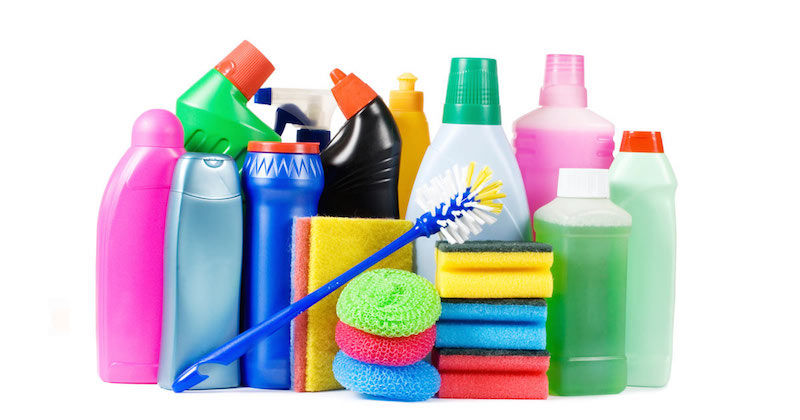Hidden Chemicals In Your Home And How To Avoid Them
Last updated on
Products that line grocery shelves and our cupboard shelves contains lots of different chemicals. From soap to soup cans, a lot of the products that we use around the house—even food packaging—may be exposing you to chemicals that disrupt your system.
Endocrine-disrupting chemicals (EDCs) are among the chemicals that have not recently been phased out of our everyday products. Known toxins like lead, mercury, and arsenic are no longer in paints, thermometers, or children’s toys, but can we still find EDCs in the goods we consume?
The answer is yes, and it’s because they’re taboo.
Nobody wants to mention chemicals used in their products, even if it’s just in the packaging. Packaged foods we buy have a list of ingredients showing what is in the products, but what about the chemicals used to make the plastic wrapping or cardboard that the products are stored in?
The Endocrine Society says that EDCs are found in everything from pesticides to personal care products, electronics and antibacterials. The chemicals are even found in textiles and clothing we live and sleep in. You can come into contact with these chemicals through oral consumption, inhalation, or skin contact.
Related: 10 Sources Of Endocrine Disruptor And How To Avoid Them
Tough To Stay Safe
“The endocrine system is really controlling almost all major processes in the body—blood pressure, metabolism, those kinds of things that are just essential for everyday function,” says Sheela Sathyanarayana, MD, associate professor of pediatrics at the University of Washington and an investigator at the Seattle Children’s Research Institute
Sathyanarayana studies the effects of EDCs on people. “These chemicals can mimic or antagonize or interfere with hormone signaling or hormone production. They disrupt the normal hormone processes in the body.”
Leonardo Trasande, MD, an endocrinologist and associate professor of pediatrics and environmental medicine at the NYU School of Medicine says, “Over the past couple of decades, increasing and emerging evidence suggests that chemicals may disrupt the function of hormones in our bodies… [and] that disruption of those hormones can produce a broad array of conditions across the life course—birth defects, obesity, diabetes, even certain cancers.”
For years we’ve been denying the risk that EDCs present. A 2013 report from the World Health Organization and the United Nations Environment Program noted a “significant knowledge gap” exists surrounding “exposures to EDCs and other endocrine diseases.”
Disease Risks Significantly Underestimated
There isn’t enough research proving that EDCs are directly correlated to negative health issues, but that doesn’t mean we shouldn’t be asking questions. Who are EDCs bad for? “Pregnant women and young children are the populations that are known to be the most vulnerable, but that doesn’t mean they are the only group that is likely to suffer death and disability from endocrine-disrupting chemicals,” says Dr. Trasande.
Another good question is: “Which chemicals do I need to be aware of? Which should I worry about?” The following is a list of known EDCs and where they are found.
- Polybrominated diphenyl ethers (PBDEs) are in furniture and textiles. Although California recently banned PBDEs they are still widely used as flame retardants. Of course prenatal exposure to these chemicals can harm a developing nervous system and lead to all sorts of cognitive and behavioral problems and impaired motor function. A study at the University of Cincinnati College of Medicine found that high levels of prenatal PBDE exposure lead to lower IQs and more hyperactivity in children when compared to peers with lower levels of exposure.
- Phthalates are used to make plastics more flexible in plastic packaging, garden hoses, detergents and children’s toys. Prenatal exposure to phthalates leads to a higher risk of allergies and potentially detrimental changes in the male reproductive system.
- Bisphenol A (BPA) prevents rust in the linings of metal cans and other food and beverage containers. Plastic water bottles are usually made containing BPA, exposure to which increases the risk of behavioral problems, obesity and diabetes, heart disease, and impaired liver function.
- Triclosan is found in kids’ toys, clothing, and kitchenware. It’s also added to soaps, toothpastes and cosmetics as an antibacterial and antifungal agent. It is a known hormone disrupter in animals and thought to cause problems with the human immune system. The FDA still maintains that “triclosan is not currently known to be hazardous to humans,” although several studies condemning the chemicals have surfaced since then.
How To Avoid EDCs
Knowing is half the battle, but now that you know about EDCs, how do you avoid them? First of all, dust frequently. EDCs accumulate in household dust, so dusting and vacuuming frequently is a must. Keep your windows open for a good airflow and to not let the dust settle.
Avoid high-fat animal products. EDCs accumulate in fat, so keep as low-fat a diet as you are able. Eating fresh fruits and veggies will also help strengthen your immune system. Avoid canned and processed foods with added chemicals. Use water filters certified to reduce contaminants.
Do not microwave food in plastic containers. In fact, don’t even use a microwave oven! Try to never let your food touch any plastics—use glass, stainless steel, ceramic, or wood containers rather than plastic ones. Don’t use polycarbonate plastics for hot liquids.
Now that you know about EDCs look at the products you use and the materials they come in. Avoid EDCs as much as you can, and eat a healthier, immune boosting diet.
Related: 8 Hormone-Healthy Foods To Boost Your Endocrine System
Source:
https://www.everydayhealth.com/news/are-chemical-dangers-hiding-your-home/
Some of the links I post on this site are affiliate links. If you go through them to make a purchase, I will earn a small commission (at no additional cost to you). However, note that I’m recommending these products because of their quality and that I have good experience using them, not because of the commission to be made.



































 JOIN OVER
JOIN OVER
Comments